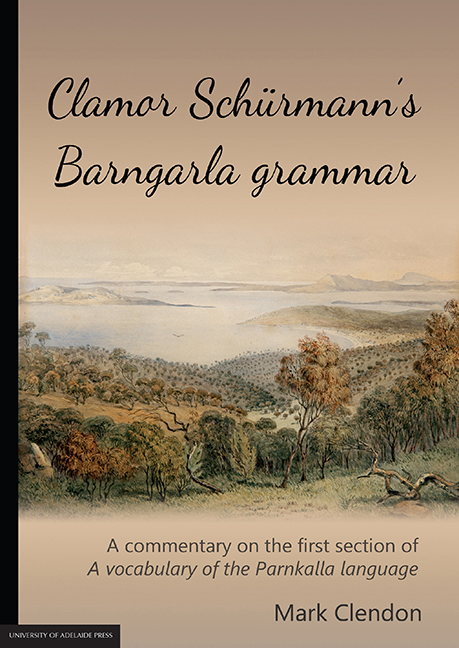 Clamor Schürmann's Barngarla grammar
Clamor Schürmann's Barngarla grammar Book contents
- Frontmatter
- Frontispiece
- Contents
- Abbreviations used in glossing sentence examples & in the text
- Preface
- Map: The northern and western Thura-Yura languages
- 1 Introduction
- 2 Writing Barngarla sounds
- 3 Pronouns
- 4 Intransitive verbs
- 5 Transitive verbs
- 6 Harry Crawford's Barngarla verbs
- 7 Suffixes on nouns
- 8 Other suffixes
- 9 Demonstrative & interrogative pronouns
- 10 Verbal derivational affixes
- 11 Non-finite verbs
- 12 Putting words together
- 13 Prospect
- Appendix The name Barngarla
- References
7 - Suffixes on nouns
Published online by Cambridge University Press: 05 February 2016
- Frontmatter
- Frontispiece
- Contents
- Abbreviations used in glossing sentence examples & in the text
- Preface
- Map: The northern and western Thura-Yura languages
- 1 Introduction
- 2 Writing Barngarla sounds
- 3 Pronouns
- 4 Intransitive verbs
- 5 Transitive verbs
- 6 Harry Crawford's Barngarla verbs
- 7 Suffixes on nouns
- 8 Other suffixes
- 9 Demonstrative & interrogative pronouns
- 10 Verbal derivational affixes
- 11 Non-finite verbs
- 12 Putting words together
- 13 Prospect
- Appendix The name Barngarla
- References
Summary
For lots of the meanings that English conveys by way of prepositions like to, from, over, under, after and so on, Barngarla uses suffixes. Schürmann provides us with a number of important shapes that are suffixed to nouns, to make meanings for which English uses prepositions.
Markedness
Across Australia a suffix -nya or -nha is widely used to mark something as being in some way different or special. The Thura-Yura languages are the same; the suffix -nha has a wide range of uses here, too. Luise Hercus describes this suffix in Kuyani as:
[a] nominal clitic with multiple functions: it can be a proper noun marker and is therefore common in placenames … it is used to ‘single out’ or particularise adjectives and is especially common in possessive adjectives … sometimes also affixed to adverbs … sometimes it is just emphatic. (Hercus 2006a)
This suffix is ubiquitous as well in Adnyamathanha, so much so that Tunstill (2004: 434) can say of it only that it is ‘of uncertain/variable meaning’, and Schebeck (1974: 4) says that it is ‘doubtlessly the most difficult to define’. Because of the ubiquity of this suffix in all Thura-Yura languages, where Schürmann has an ending -nna or -na, and where I am unable to find a context for such an ending in another language, I will cautiously and rather reluctantly assume that this shape could be phonemic -nha, and proceed as if it were.
Plural & dual
In Australia as elsewhere, it is frequently the case that only human nouns, or nouns that refer to highly animate things, may take marking for non-singular number (dual or plural): usually men, women, dogs and/or children. Schürmann has the following, repeated here with suggested phonemic representations:
Both Adnyamathanha and Kuyani show two forms of the dual-marking suffix, -alypila and -alpila (Hercus 2006, Tunstill 2004: 428). Schürmann spells the Barngarla equivalent -lbelli, without indication of fronting and raising of a preceding vowel: so, yurralbelli and pallalbelli, not xyurrailbelli or xpallailbelli. This makes the shape of the Barngarla suffix as -lbili certain. Schürmann says that this suffix is an abbreviation of the number kalbelli ‘two’, which is phonemic galbili. Nhukunu has paarla ‘woman’ (Hercus 1992: 26), and I will presume that the rhotic in the Barngarla word copies the place of articulation (retroflex) of the preceding lateral consonant.
- Type
- Chapter
- Information
- Clamor Schürmann's Barngarla grammarA commentary on the first section of A vocabulary of the Parnkalla language, pp. 71 - 92Publisher: The University of Adelaide PressPrint publication year: 2015


